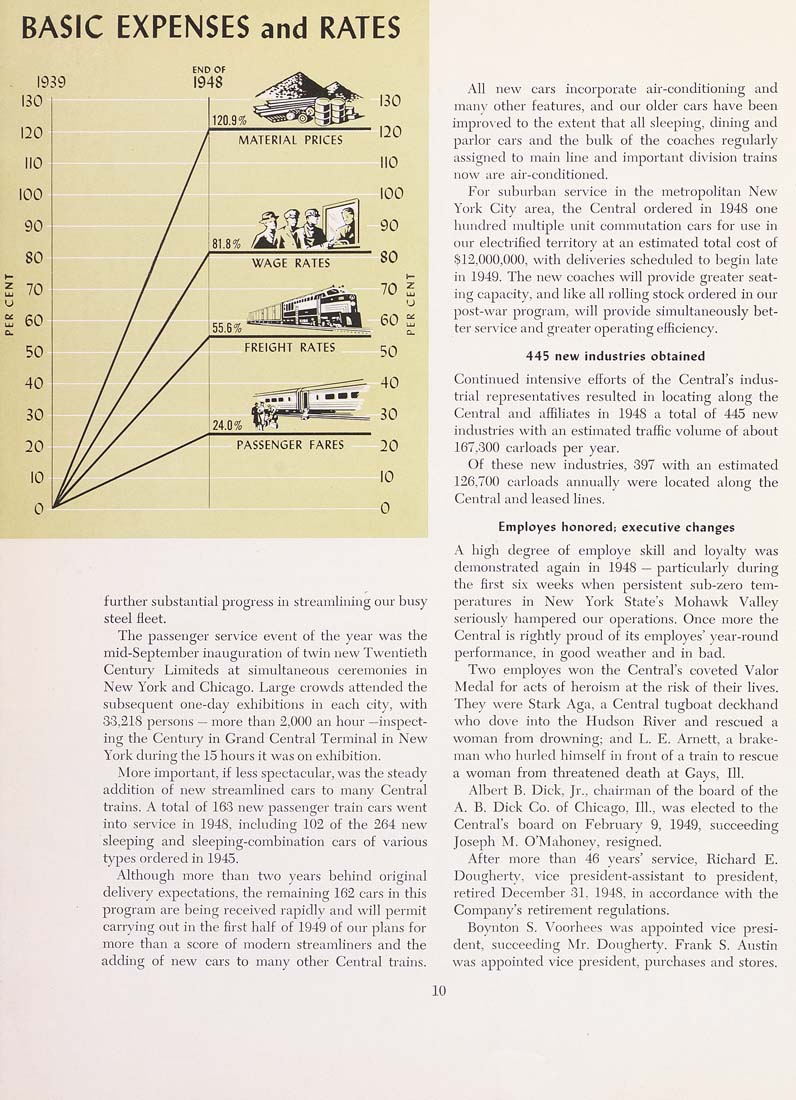BASIC EXPENSES and RATES
1939
130
120
no
100
90
80
i 70
; 60
50
40
30
20
10
0
fui'ther substantial progress in streamlining our busy
steel fleet.
The passenger service event of the year was the
mid-September inauguration of twin new Twentieth
Century Limiteds at simultaneous ceremonies in
New York and Chicago. Large crowds attended the
subsequent one-day exhibitions in each city, with
33,218 persons — more than 2,000 an hour —inspect¬
ing the Century in Grand Central Terminal in New
York during the 15 hours it was on exhibition.
More important, if less spectacular, was the steady
addition of new streamlined cars to many Central
trains. A total of 163 new passenger train cars went
into service in 1948, including 102 of the 264 new
sleeping and sleeping-combination cars of various
types ordered in 1945.
Although more than two years behind original
delivery expectations, the remaining 162 cars in this
program are being received rapidly and will permit
carrying out in the first half of 1949 of our plans for
more than a score of modern streamliners and the
adding of new cars to many other Central trains.
All new cars incorporate air-conditioning and
manv other features, and our older cars have been
impro\"ed to the extent that al! sleeping, dining and
parlor cars and the bulk of the coaches regularly
assigned to main line and important division trains
now are air-conditioned.
For suburban service in the metropolitan New
York City area, the Central ordered in 1948 one
himdred multiple unit commutation cars for use in
our electrified territory at an estimated total cost of
$12,000,000, with deliveries scheduled to begin late
in 1949. The new coaches will provide greater seat¬
ing capacity, and like all rolling stock ordered in our
post-war program, will provide simultaneously bet¬
ter service and greater operating efficiency.
445 new industries obtained
Continued intensive efi:orts of the Central's indus¬
trial representatives resulted in locating along the
Central and affiliates in 1948 a total of 445 new
industries with an estimated traffic volume of about
167,300 carloads per year.
Of these new industries, 397 with an estimated
126,700 carloads annually were located along the
Central and leased lines.
Employes honored; executive changes
A high degree of employe skill and loyalty was
demonstrated again in 1948 — particularly during
the first six weeks when persistent sub-zero tem¬
peratures in New York State's Mohawk Valley
seriously hampered our operations. Once more the
Central is rightly proud of its employes' year-round
performance, in good weather and in bad.
Two employes won the Centi-al's coveted Valor
Medal for acts of heroism at the risk of their lives.
They were Stark Aga, a Central tugboat deckhand
\vho dove into the Hudson River and rescued a
woman from drowning; and L, E. Arnett, a brake-
man who hurled himself in front of a train to rescue
a woman from threatened death at Gays, 111.
Albert B. Dick, Jr., chairman of the board of the
A. B. Dick Co. of Chicago, 111., was elected to the
Central's board on February 9, 1949, succeeding
Joseph M. O'Mahoney, resigned.
After more than 46 years' service, Richard E.
Dougherty, vice president-assistant to president,
retired December 31, 1948, in accordance with the
Company's retirement regulations.
Boynton S. Voorhees was appointed vice presi¬
dent, succeeding Mr. Dougherty. Frank S. Austin
was appointed vice president, purchases and stores.
|








